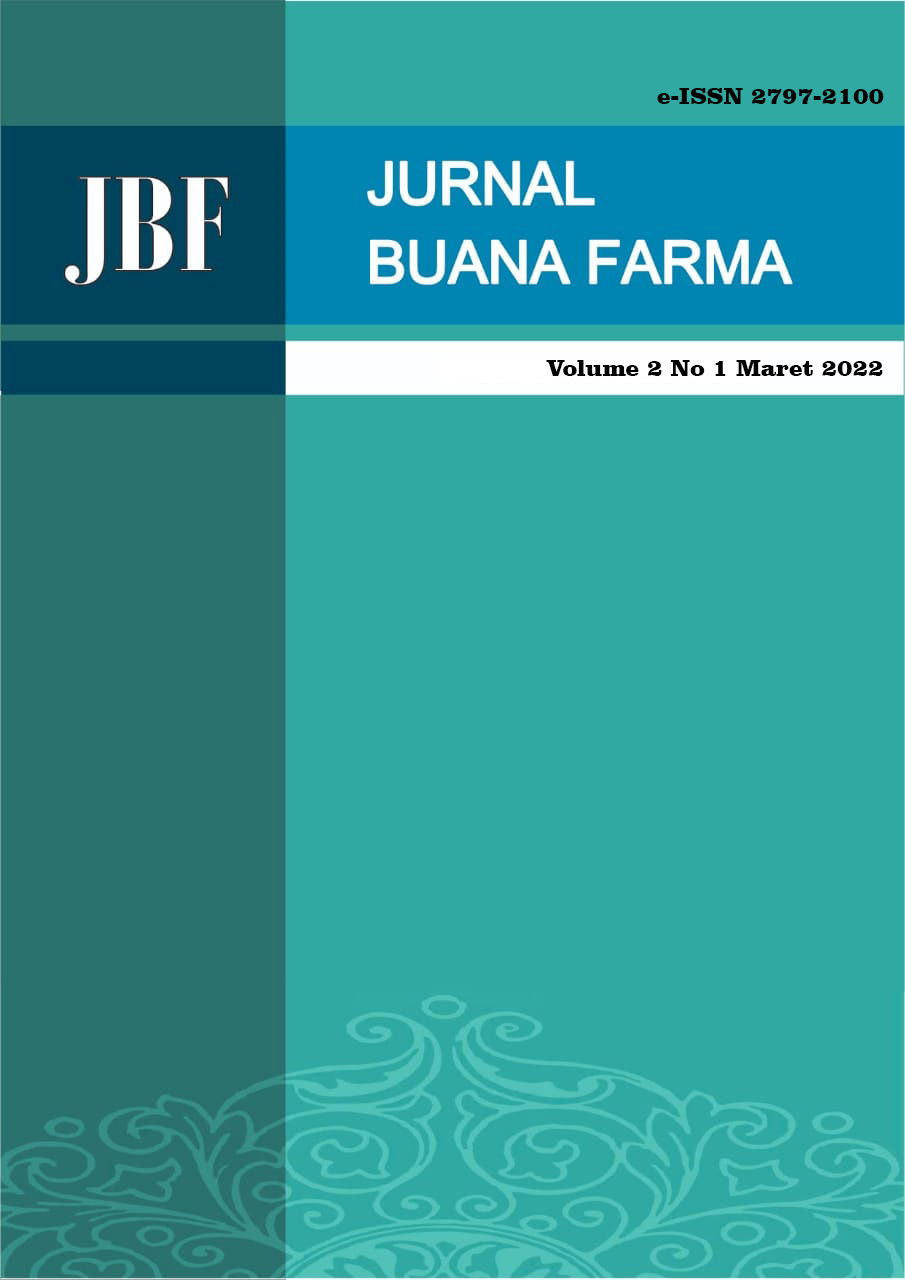SKRINING FITOKIMIA DAN UJI AKTIFITAS ANTIBAKTERI EKSTRAK DAUN TELANG (Clitoria ternatea L.) TERHADAP BAKTERI Pseudomonas aeruginosa
Abstract
Telang leaf (Clitoria ternatea L.) is one of the plants that is often used as a traditional medicine by the people of Indonesia to cure infections which is used by attaching it to the sore, wound or swollen part. The purpose of this study was to determine the antibacterial bioactivity of n-hexane, ethyl acetate, and methanol extracts of telang leaf against Pseudomonas aeruginosa bacteria and to determine the content of secondary metabolites in the extracts of n-hexane, ethyl acetate, and methanol qualitatively by phytochemical screening and thin layer chromatography. The method used in this study is the antibacterial method of pitting with a concentration of 40%, 60%, 80%, 100%, phytochemical screening, and thin layer chromatography with specific spot appearance. The best potential antibacterial bioactivity between n-hexane, ethyl acetate, and methanol extract of telang leaf (Clitoria Ternatea L.) against Pseudomonas aeruginosa is the methanol extract of telang leaf (60%) which has an inhibition zone of 18.57 mm, strong category and based on supporting data. qualitatively by phytochemical screening containing secondary metabolites, namely flavonoids, saponins, tannins, quinones, polyphenols and triterpenoids/steroids as well as TLC results with the appearance of specific Liebermen burchard (LB) spots that are positive blue-black in color, suspected as an antibacterial of the triterpenoid/steroid secondary metabolite group.
References
Alhaddad, Z., Wahyudi, D., & Tanod, A. W. (2019). Bioaktivitas Antibakteri Dari Ekstrak Daun Mangrove Avicennia SP Aantibacterial Bioactifity Of Mangrove Leaf Extract Avicennia SP. Jurnal Kelautan, Volume 12, No.1.
Asih, I. A. (2009). Isolasi Dan Identifikasi Senyawa Isoflavon Dari Kacang Kedelai (Glycine max). Jurnal Kimia 3, 33-40.
Harbone, J. B. (1996). Metode Fitokimia penuntun cara modern menganalisis tumbuhan. Bandung: Penerbit ITB Bandung.
Purba, E. C. (2020). Kembang Telang (Clitoria ternatea L.): Pemanfaatan dan Bioaktivitas. Jurnal EduMatSains, 111-124.
Riswadi. (2010). Uji Aktivitas Antibakteri Ekstrak Metanol Larut Heksan Dan Tidak Larut Heksan Daun Kembang Telang (Clitoria Ternatea L.) Terhadap Beberapa Bakteri Patogen. Makasar: Skripsi Fakultas Ilmu Kesehatan Uin Alauddin Makassar.
Romadanu, Rachmawati, S. H., & Lestari, S. D. (2014). Pengujian Aktivitas Antioksidan Ekstrak Bunga Lotus (Nelumbo nucifena). Fishtech, 1-7.
Safitri, Y. Y., Ningrum, W. A., & Zuhana, N. (2018). Perbandingan Uji Aktivitas Antibakteri Ekstrak Etanol Daging Buah dan Daun Carica (carica pubescens) beserta Kombinasinya terhadap Bakteri Staphylococcus aureus atcc. Health Sciences and Pharmacy Journal, 1-12.
Suganda, T., Komalasari, P., Yulia, E., & Natawigena, W. (2020). Uji In Vitro Keefektifan Ekstrak Air Daun Dan Bunga Kembang Telang (Clitoria ternatea l.) terhadap Jamur Alternaria solani Penyebab Penyakit Bercak Coklat pada Tanaman Tomat. Jurnal Agrikultura, 88-96.
Trisia, A., Philyria, R., & Toemon, A. N. (2018). Uji Aktivitas Antibakteri Ekstrak Etanol Daun Kalanduyung (Guazuma ulmifolia Lam.) terhadap Pertumbuhan Staphylococcus aureus dengan Metode Difusi Cakram (Kirby-bauer). Anterior Jurnal, 136-143.
Utomo, S. B., Fujiyanti, M., Lestari, W. P., & Mulyani, S. (2018). Uji Aktivitas Antibakteri Senyawa C-4-Metoksifenilkalik[4]Resorsinarena Termofifikasi Hexadecyltrimethylammonium-Bromide terhadap Bakteri Staphylococcus aureus dan Escherichia coli. JKPK (Jurnal Kimia dan Pendidikan Kimia), 201-209.













